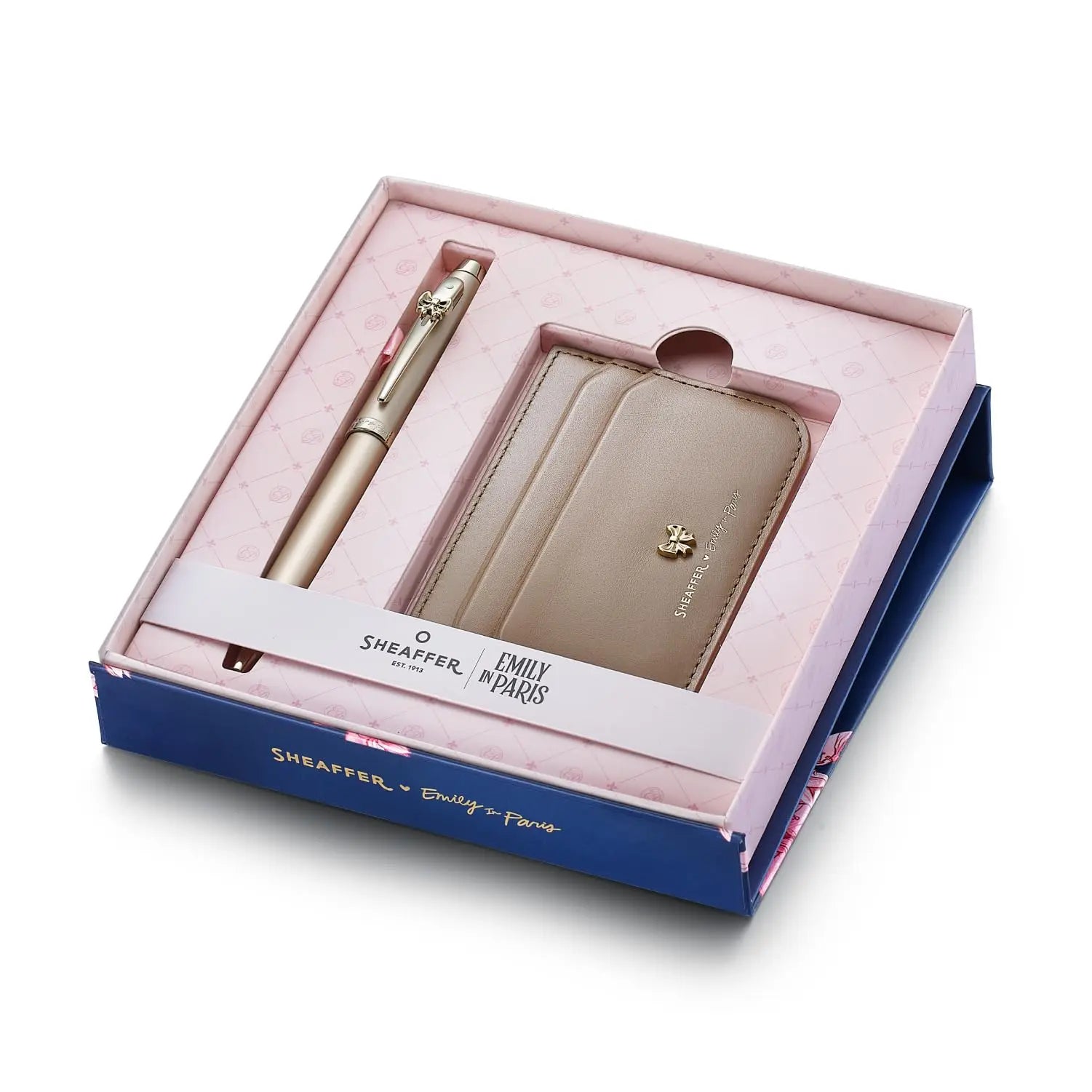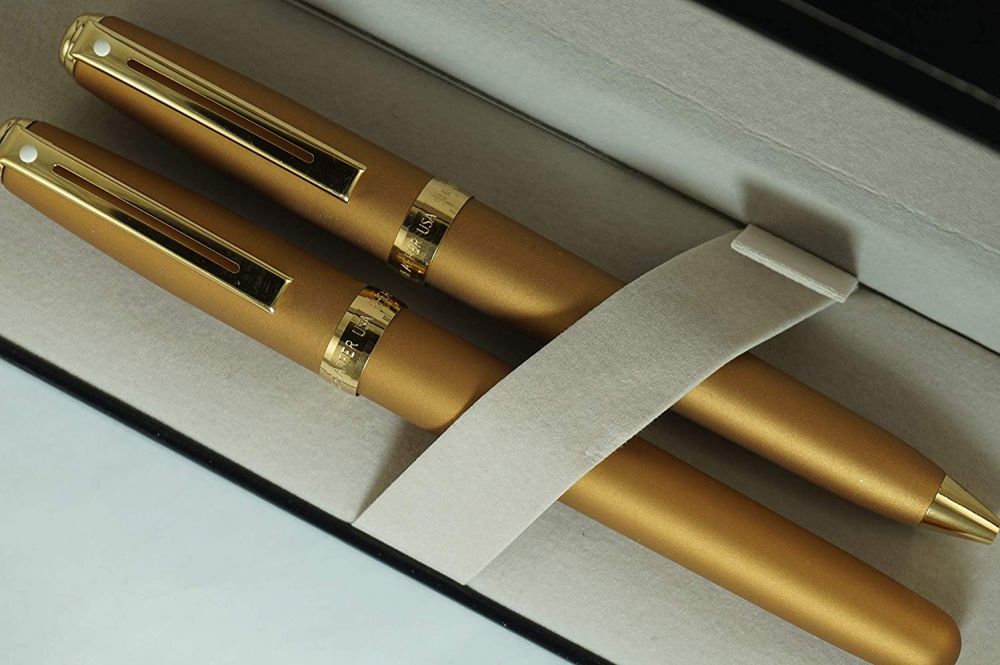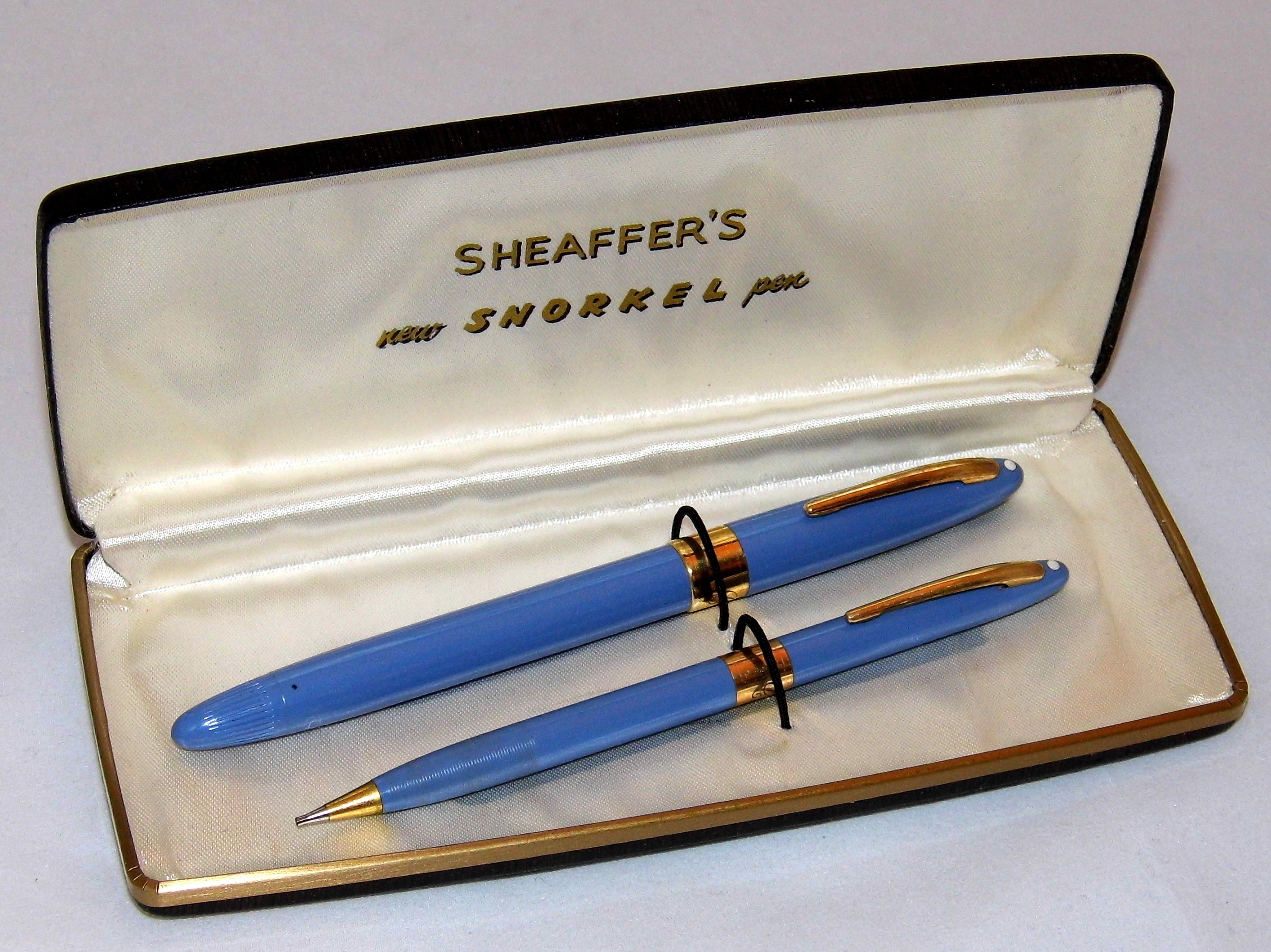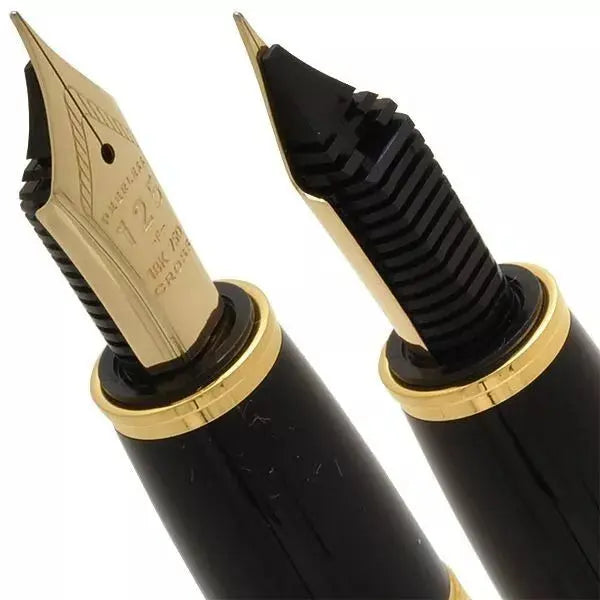Early Beginnings and Innovations
The story of Sheaffer pens began in 1912 with Walter A. Sheaffer, a visionary jeweler from Fort Madison, Iowa. Dissatisfied with the cumbersome process of refilling fountain pens, Sheaffer sought to create a more user-friendly writing instrument. His goal was to develop a pen that was not only easy to refill but also reliable and elegant, reflecting the high standards of craftsmanship that defined his jewelry business. With this ambition, Sheaffer founded the W.A. Sheaffer Pen Company and began a journey of innovation that would revolutionize the writing instrument industry.
Sheaffer's early innovations were characterized by a relentless pursuit of perfection. He understood that to stand out in a competitive market, his pens needed to offer something unique. This led to a focus on developing proprietary filling mechanisms and enhancing the overall design and functionality of his pens. By prioritizing quality and usability, Sheaffer quickly established his company as a leader in the industry, setting the stage for future advancements.
Introduction of the Lever-Filling System
One of Walter Sheaffer’s most groundbreaking contributions was the introduction of the lever-filling system in 1912. Before this invention, fountain pens were notoriously difficult to refill, often requiring a separate eyedropper to transfer ink into the pen’s reservoir. This process was not only messy but also time-consuming, deterring many potential users from adopting fountain pens.
The lever-filling system changed everything. Sheaffer’s innovative mechanism featured a lever integrated into the pen’s barrel. When lifted, the lever compressed a rubber sac inside the pen, creating a vacuum that would draw ink directly into the reservoir when the lever was released. This simple yet effective solution made refilling the pen quick, clean, and hassle-free. The lever-filling system became a defining feature of Sheaffer pens, distinguishing them from other brands and solidifying the company's reputation for practical and user-friendly design.
The White Dot: A Symbol of Excellence
In the 1920s, Sheaffer introduced another iconic element that would come to symbolize the brand’s commitment to quality: the White Dot. Initially, the White Dot was used to denote Sheaffer’s premium pens, which were backed by a lifetime warranty. This small, unassuming emblem quickly grew to represent much more than just a warranty—it became a mark of excellence, reliability, and superior craftsmanship.
The White Dot reassured customers that they were purchasing a pen of the highest quality, one that would perform reliably and last a lifetime. This emblem helped to elevate Sheaffer’s status in the market, appealing to professionals, writers, and anyone who valued a dependable and well-crafted writing instrument. Over the years, the White Dot has remained a trusted symbol, reflecting Sheaffer's enduring dedication to producing exceptional pens.
The history of Sheaffer pens is a testament to innovation, quality, and a steadfast commitment to excellence. From the early beginnings and Walter A. Sheaffer’s revolutionary lever-filling system to the introduction of the iconic White Dot, Sheaffer has consistently pushed the boundaries of what a writing instrument can achieve. These innovations not only transformed the industry but also established Sheaffer as a trusted and respected name in the world of writing. Today, Sheaffer continues to honor its rich legacy while embracing modern advancements, ensuring that its pens remain cherished by writers and professionals around the globe.
The 1920s and 1930s: Expansion and Success
The 1920s and 1930s were a period of remarkable growth and success for the Sheaffer Pen Company. Following the introduction of the lever-filling system and the establishment of the White Dot as a symbol of quality, Sheaffer continued to innovate and expand its product line. This era saw the company solidify its position as a leader in the fountain pen industry.
During the 1920s, Sheaffer introduced several new models that quickly gained popularity. The company’s Balance pen, introduced in 1929, was particularly noteworthy. With its streamlined design and improved ergonomics, the Balance pen set new standards for comfort and style in writing instruments. The Balance's innovative design and appealing aesthetics made it a favorite among consumers and helped to drive the company’s expansion.
In addition to product innovations, Sheaffer invested heavily in marketing and advertising. The company's advertisements emphasized the quality and reliability of Sheaffer pens, as well as their sophisticated design. By the 1930s, Sheaffer had established a global presence, with its pens being sold in numerous countries around the world. This period of expansion was marked by increased production capacity and the establishment of a strong distribution network, ensuring that Sheaffer pens were readily available to a growing number of customers.
World War II and Post-War Era Developments
The onset of World War II brought significant challenges and changes to the Sheaffer Pen Company. During the war, many materials essential to pen manufacturing were in short supply due to wartime restrictions. In response, Sheaffer adapted by exploring alternative materials and manufacturing processes. The company’s ability to innovate under pressure not only allowed it to maintain production but also led to new developments in pen design and technology.
One of the notable adaptations during this period was the use of military-grade plastics and other durable materials to produce pens that could withstand harsh conditions. Sheaffer pens were widely used by soldiers, and the brand earned a reputation for reliability and toughness. This period also saw the introduction of the Sheaffer Triumph nib, a conical nib design that provided a smoother writing experience and greater durability.
Following the end of World War II, Sheaffer experienced a surge in demand as economies recovered and consumer spending increased. The post-war era was marked by significant technological advancements and a renewed focus on innovation. In 1949, Sheaffer introduced the Snorkel pen, an engineering marvel that featured a unique filling mechanism allowing the pen to be filled without dipping the nib into ink. This innovation highlighted Sheaffer’s commitment to combining practicality with advanced design.
The 1950s also saw the introduction of the Pen For Men (PFM) line, which featured bold, modern designs and advanced filling systems. The PFM pens were targeted at a professional market, emphasizing both functionality and style. These post-war developments helped Sheaffer to maintain its competitive edge and continue its tradition of excellence in pen manufacturing.
The 1920s and 1930s were a time of significant expansion and success for the Sheaffer Pen Company, marked by innovative product introductions and strategic marketing efforts. Despite the challenges posed by World War II, Sheaffer’s ability to adapt and innovate allowed it to emerge from the war stronger than ever. The post-war era brought about some of Sheaffer’s most iconic developments, ensuring that the brand remained at the forefront of the writing instrument industry. Today, Sheaffer's legacy of quality and innovation continues to inspire and influence the design of modern writing instruments.
Signature Models: The Balance and the Triumph
Among Sheaffer's many achievements, the introduction of the Balance and Triumph models stand out as pivotal moments in the company’s history. These signature models not only exemplified Sheaffer's commitment to innovation and quality but also set new standards in the design and functionality of fountain pens.
Introduced in 1929, the Sheaffer Balance pen was revolutionary in its design. Unlike the traditional cylindrical shape of earlier pens, the Balance featured a streamlined, tapered design that improved both the aesthetics and ergonomics of the pen. The Balance was lighter and more comfortable to hold, making writing for extended periods much more enjoyable. Available in a variety of colors and finishes, the Balance quickly became a favorite among consumers and solidified Sheaffer’s reputation as a leader in pen design.
Following the success of the Balance, Sheaffer introduced the Triumph pen in 1942. The Triumph was notable for its conical Triumph nib, which provided a smoother and more consistent writing experience. This nib design was not only functional but also durable, making it ideal for a variety of writing styles and preferences. The Triumph pen was also equipped with Sheaffer’s innovative filling systems, including the lever-filling and later the Touchdown mechanism, further enhancing its appeal. These models demonstrated Sheaffer’s ability to blend form and function, creating pens that were both beautiful and highly practical.
Technological Advancements: The Snorkel and PFM
Sheaffer's commitment to technological advancement continued into the post-war era with the introduction of the Snorkel and PFM models, which showcased the company’s ability to innovate and adapt to changing consumer needs.
In 1952, Sheaffer unveiled the Snorkel pen, a marvel of engineering that addressed one of the main challenges of fountain pens: the messy filling process. The Snorkel pen featured a unique filling mechanism that allowed users to fill the pen without dipping the nib into the ink bottle. Instead, a thin tube (the snorkel) extended from the nib and into the ink. When the user operated the filling mechanism, ink was drawn up through the snorkel, leaving the nib clean and ready for use. This innovation not only made the filling process cleaner and more efficient but also protected the nib from potential damage caused by repeated dipping and cleaning. The Snorkel pen was a huge success and became one of Sheaffer’s most iconic models.
Building on the success of the Snorkel, Sheaffer introduced the Pen For Men (PFM) line in 1959. The PFM was designed with a bold, modern aesthetic and featured advanced technology that appealed to professionals seeking both style and functionality. The PFM incorporated the Touchdown filling mechanism, which provided a quick and reliable way to fill the pen with ink. The pen’s robust construction and innovative design elements, such as the inlaid nib, made it a favorite among discerning users who appreciated quality craftsmanship and cutting-edge technology.
The Balance and Triumph models exemplified Sheaffer’s dedication to innovative design and superior functionality, setting new benchmarks in the industry. The introduction of the Snorkel and PFM pens further showcased Sheaffer's ability to lead technological advancements in writing instruments. These models not only addressed practical challenges but also enhanced the overall user experience, cementing Sheaffer's position as a pioneer in the field. Through these signature models and technological advancements, Sheaffer continued to build on its legacy of excellence, creating writing instruments that remain cherished by enthusiasts and professionals alike.
Ownership Changes and Corporate Evolution
Throughout its long history, the Sheaffer Pen Company has undergone several ownership changes and periods of corporate evolution, each bringing new opportunities and challenges. These changes have shaped the company's direction and helped it adapt to the evolving market for writing instruments.
In 1966, Sheaffer was acquired by Textron Inc., a major conglomerate with diverse business interests. Under Textron's ownership, Sheaffer continued to innovate and produce high-quality pens, benefiting from the financial stability and resources provided by its parent company. However, as the market for writing instruments became more competitive, Sheaffer faced increasing pressure to differentiate itself from emerging brands and technologies.
In 1997, French stationery giant Bic acquired Sheaffer, ushering in a new era of change. Bic, known for its mass-market pens and disposable writing instruments, aimed to leverage Sheaffer's reputation for quality to expand its presence in the premium pen market. Despite the challenges of integrating two distinct brand philosophies, the acquisition allowed Sheaffer to reach a broader audience and maintain its commitment to excellence.
The most recent significant change in ownership occurred in 2014 when A. T. Cross Company, another historic name in the pen industry, acquired Sheaffer. This merger brought together two venerable brands with rich histories of innovation and craftsmanship. Under Cross's stewardship, Sheaffer has continued to evolve, balancing the preservation of its storied legacy with the demands of contemporary consumers.
Modern-Day Sheaffer: Balancing Tradition and Innovation
In the modern era, Sheaffer faces the challenge of maintaining its heritage while embracing new trends and technologies. The company has managed to strike this balance by honoring its traditions and continually pushing the boundaries of pen design and functionality.
Today, Sheaffer offers a diverse range of writing instruments that cater to different tastes and preferences. Classic models, such as the Balance and Triumph, are still celebrated for their timeless design and exceptional performance. These heritage products appeal to collectors and enthusiasts who appreciate the historical significance and craftsmanship of Sheaffer's early innovations.
At the same time, Sheaffer has introduced new lines that incorporate modern materials and technologies. For instance, the Sheaffer 100 and Sheaffer Intensity collections blend contemporary aesthetics with reliable performance, appealing to a new generation of users. These modern designs retain the core values of quality and craftsmanship that have always defined the Sheaffer brand.
Sheaffer has also embraced advancements in ink technology, offering a variety of fountain pen inks and refills that enhance the writing experience. The company’s commitment to sustainability is reflected in its efforts to develop eco-friendly products and packaging, aligning with broader industry trends towards environmental responsibility.
Furthermore, Sheaffer continues to innovate with new filling mechanisms and ergonomic designs that improve the usability and convenience of its pens. By integrating modern technology while preserving the elegance and sophistication of traditional penmanship, Sheaffer remains a relevant and respected name in the writing instrument industry.
The history of Sheaffer pens is marked by significant ownership changes and corporate evolution, each phase contributing to the brand's resilience and adaptability. Through the guidance of various parent companies, Sheaffer has navigated the challenges of a competitive market while staying true to its legacy of quality and innovation. In the modern era, Sheaffer successfully balances tradition with innovation, offering writing instruments that honor its storied past while meeting the needs of contemporary consumers. This dynamic approach ensures that Sheaffer continues to be a cherished name in the world of writing instruments, valued by both longtime aficionados and new enthusiasts alike.
Sheaffer Pens in Popular Culture and the Collectibles Market
Sheaffer pens have not only left an indelible mark in the world of writing instruments but have also made significant appearances in popular culture, cementing their status as iconic symbols of style, sophistication, and craftsmanship.
In film and television, Sheaffer pens have been featured prominently, often wielded by characters to convey authority, intelligence, and elegance. From classic Hollywood films to contemporary television series, Sheaffer pens have graced the hands of leading actors, adding an air of authenticity and refinement to their portrayals. Whether used as props in period dramas or as tools of diplomacy in political thrillers, Sheaffer pens have become synonymous with power, prestige, and timeless elegance.
Beyond the screen, Sheaffer pens have also captured the imagination of collectors around the world. Vintage Sheaffer models, such as the Balance and Triumph, are highly sought after by enthusiasts who appreciate their historical significance and exquisite craftsmanship. These pens, with their unique designs and precision engineering, command premium prices in the collectibles market, often fetching thousands of dollars at auctions and specialty pen shows.
The iconic Sheaffer White Dot, with its association with quality and reliability, has become a badge of honor for collectors, signifying pens that have stood the test of time and retained their allure over the years. Limited edition releases, commemorative sets, and collaborations with renowned artists and designers further add to the appeal of Sheaffer pens as coveted collectibles.
In addition to their cultural significance and collectible value, Sheaffer pens continue to be prized possessions for writers, professionals, and enthusiasts alike. With their rich heritage, innovative designs, and commitment to excellence, Sheaffer pens remain timeless classics that inspire creativity, elevate style, and stand as enduring symbols of craftsmanship and refinement. Whether as treasured heirlooms passed down through generations or as prized acquisitions in a growing collection, Sheaffer pens continue to leave an indelible mark on those who appreciate the art of writing and the beauty of fine craftsmanship.






